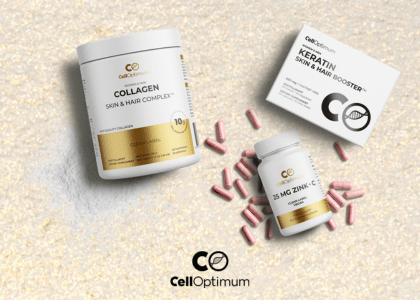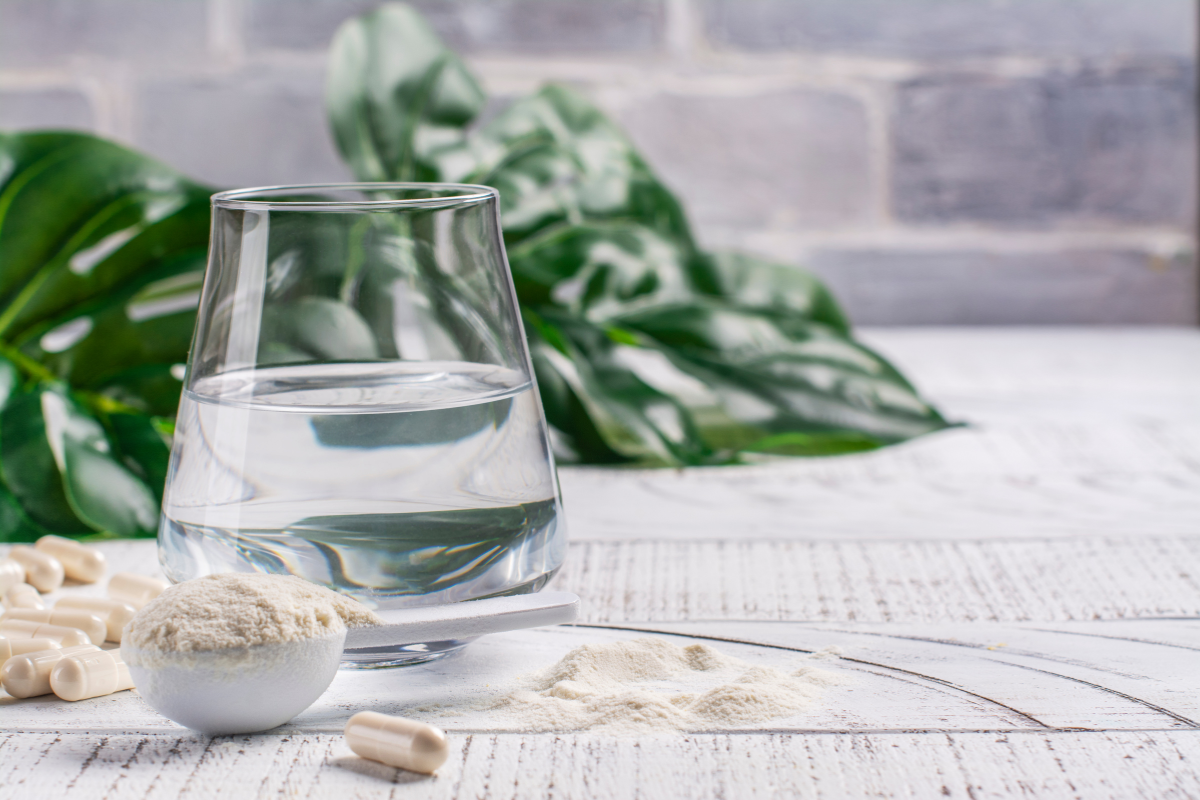Gray hair dietary supplement - ANTI-GRAY™

Gray hair supplement - ANTI-GRAY™
Melanin supplements for a natural hair color that counteracts gray hair
The best natural supplement without additives with melanin for hair color and skin tone
Melanin is the pigment responsible for our beautiful variety of skin tones and shades, eye colors, and hair colors. Melanin also protects against the harmful effects of ultraviolet (UV) rays. Melanin absorbs harmful ultraviolet light and protects the skin from the sun's harmful UV rays. The more melanin, the better the protective barrier against the effects of sun exposure. Melanin is also the pigment that gives hair its color, and it is melanin that keeps gray hair away.
What is melanin?
Melanin is a class of biological pigments that protect the skin from things like wrinkles and sagging skin. Pigment cells called melanocytes produce melanin in the outer layer of the skin. All melanocytes produce melanin, but cells in dark-skinned people produce more melanin per cell. The two types of melanin produced in human skin include black-brown, eumelanin, and yellowish-red, pheomelanin. Each melanin has distinct biological properties. Women produce 3 to 4 percent less melanin in their skin than men.
Melanin is also the pigment that gives hair and eyes their color. When hair starts to turn white or gray, not all of the hair is affected. Gray hairs start to appear when there is still some naturally colored hair left. White hair only appears when all the color in the hair is gone. Every hair on our body has its own cycle. Each hair grows, absorbs nutrients for health and growth, falls out, and then grows back again. Each hair gets its own dose of melanin, and while some get enough melanin, there are some that don't, so these become light, while others become dark. What you notice is that the hair appears to be turning gray; when in fact it is a mixture of colored, gray, or white hair. As the person gets older and the body's ability to produce melanin begins to slow down, all the hair in the body turns gray or white, and that's when you start to see all the hair as white.
What determines our hair color?
Hair color is determined by the amount of a pigment called melanin in the hair. An excess of one type of melanin, called eumelanin, gives people black or brown hair. An excess of another pigment, called pheomelanin, gives people red hair.
Why should I take a melanin supplement?
The benefits of melanin for you in each supplement are listed below:
SKIN
- Protects the skin from the sun's UV rays by improving and increasing the skin's natural defenses
- Increases and improves tan by stimulating melanogenesis
- Enhances, accelerates and prolongs the effect of a beautiful tan
- Regenerates the epidermis
ANTI-GRAY™ GRAY HAIR
HAIR
- Prevents the appearance of gray hair
- Stimulates melanogenesis and restores natural hair color
- Restores healthy and vital hair
Are melanin and melatonin the same thing?
No. Although the terms sound similar, they refer to different things. Melanin is a pigment responsible for skin tone. Melatonin is a hormone that regulates your sleep. Melatonin is a hormone produced by the pineal gland from tryptophan. The effect of melatonin is to make you sleepy, and the secretion of melatonin is probably the body's main mechanism for making us sleepy.
Why do you get tan?
Melanin is the pigment that gives skin, hair and eyes their color. Dark-skinned people have more melanin in their skin than fair-skinned people. Melanin provides some protection against skin damage caused by the sun, by causing melanocytes to increase their production of melanin in response to sun exposure, which makes us tan.
Can melanin protect the skin from UV radiation?
Melanins are a group of pigments that give rise to the color of our skin, hair, and eyes. While melanins have several functions in our bodies, their most important function is probably to protect our skin from the harmful effects of sunlight.
There are two basic classes of melanins:
Pheomelanin is a melanin found in smaller amounts in skin and hair. Light-skinned people have larger amounts of pheomelanin than dark-skinned people. Pheomelanin contains the amino acid cysteine, which gives red/yellow tones, and pheoalanine is found in large amounts in red hair and also contributes to the reddish color of freckles.
Eumelanin is the most common melanin in human skin and hair, and dark-skinned people have more eumelanin. Eumelanin colors hair from brown to black, and eumelanin is also the form of melanin that is usually missing in albinism.
All melanins are produced by melanocytes, which are a type of cell in our outermost layer of skin (epidermis). Specifically, melanocytes are located at the bottom of the epidermis and they generate melanin inside membrane-bound structures called melanosomes. Melanocytes transfer melanosomes to the cells above, i.e. to the keratinocytes, these keratinocytes are the dominant cell type in our outermost layer of skin.
Can melanin protect against skin cancer?
Melanin's essential function is to protect our skin from harmful UV rays from sunlight. UV exposure is the biggest cause of skin cancer.
What is the difference between UVA and UVB radiation?
You've probably heard of UVA and UVB rays, but here's a quick reminder of how different they are. UVA rays are the longer wavelength rays and represent the majority of UV radiation reaching the atmosphere. UVB rays have shorter wavelengths and only make up a minority of UV radiation.
As the ozone layer becomes thinner, we are exposed to more and more UVB rays, which is worrying because UVB rays are the rays that are most harmful and mutagenic (can cause mutations). UVA rays are also harmful to our genes, and UVA rays reach us even when we are sitting in the shade. UVA rays penetrate deeper into the skin than UVB rays do, and can have mutagenic effects in the dermis, i.e. the second layer of our skin that lies below the epidermis (the outermost layer of skin).
Can UVB rays lead to skin cancer?
Both UVA and UVB rays can cause genetic mutations in our DNA. Fortunately, we have proteins to detect and repair DNA mutations. If a mutation is not detected and repaired, the mutation multiplies as the cell divides. And if the mutation is in certain genes, it can lead to cancer.
In the two most common types of skin cancer, mutations associated with UVB damage are found in over 50% of patients.
How does melanin protect against skin cancer?
Melanin protects our skin from light in several ways. It absorbs and redistributes the light energy from UV rays, and it protects our genetic material (DNA), which is stored in the cell nucleus, from the rays.
What is the connection between melanin and skin cancer?
Light-skinned people are about 70 times more likely to develop skin cancer than dark-skinned individuals, suggesting that pigmentation is a key factor in skin cancer. The difference lies not in the number of melanin-producing melanocytes, but in the amount of melanin produced. Asian individuals have, on average, twice as much melanin as Caucasians, while Africans have about three to six times as much melanin. Since the rates of skin cancer in light-skinned and dark-skinned people differ by a factor of 70, factors other than melanin are clearly contributing factors.
Another contributing factor may have to do with the lifespan of the melanosome. One study found that melanosomes in dark-skinned people are more resistant to cell degradation (when cells become too unstable in an organism, resulting in its eventual death) than in light-skinned individuals.
Can melanin be used as a sun protection factor?
Melanin, as a sunscreen, has an SPF, or sun protection factor. Scientists debate exactly how much SPF melanin has, but it's around SPF 1.5 - 2 and can be as high as 4. That may not sound like much, but an SPF of 2 represents double the amount of protection from the sun. If you think about it another way, melanin absorbs about half of the UV light we're exposed to.
Why does UV light make you tan?
Following DNA damage or repair from UV light exposure, melanin production is increased, creating a tanned skin. How skin pigmentation is regulated is not well understood but is likely to be the subject of future research. In mammals, more than 120 genes are known to have a role in pigmentation.
In other words, when the skin is exposed to the sun's UVB radiation, it gradually forms a pigment – melanin – that protects against primarily UVB radiation, and causes the skin to tan. This production of melanin is called melanogenesis. The increased production of melanin is a reaction to the DNA damage caused by UV radiation. Melanogenesis leads to delayed tanning, which typically becomes visible two or three days after exposure.
UVA radiation does not cause sunburn, but reaches deeper into the skin and can break down the connective tissue protein collagen , which, among other things, accelerates skin aging and makes the skin wrinkled and inelastic.
Can you increase the body's melanin?
People with any skin type can increase melanin to reduce their risk of skin cancer. Studies suggest that increasing intake of certain nutrients can increase melanin levels.
NUTRIENTS CAN INCREASE MELANIN
There are many nutrients that are believed to increase melanin and can improve overall skin health, which may reduce the overall risk of developing skin cancer.
DIFFERENT WAYS TO INCREASE MELANIN IN THE BODY
Nutrients may be the key to increasing melanin naturally in your skin. Here are some nutrients that can help your body produce more melanin.
ANTIOXIDANTS
Antioxidants show the strongest potential for increasing melanin production. Although more studies are needed, some research suggests that antioxidants may help.
Micronutrients such as flavonoids or polyphenols, which come from the plants we eat, act as powerful antioxidants and can affect melanin production. Some of them increase melanin , while others can help reduce it.
Eat more antioxidant-rich foods like dark leafy greens, dark berries, dark chocolate, and colorful vegetables to get more antioxidants. Taking a vitamin and mineral supplement can also help.
VITAMIN A (RETINOL)
Studies suggest that vitamin A is important for melanin production and is essential for healthy skin. You get vitamin A from the food you eat, especially vegetables that contain beta-carotene, such as carrots, sweet potatoes, spinach, and peas.
Because vitamin A also acts as an antioxidant, some researchers believe that this vitamin, more than anything else, may be key to melanin production. However, more studies are still needed to directly prove that vitamin A increases melanin in humans.
However, some studies suggest that taking vitamin A (specifically retinol) may be good for skin health.
A type of carotenoid (the substance that gives red, yellow, and orange vegetables their color) is found in vitamin A. It may also play a role in melanin production and UV protection, according to research.
Vitamin A is found in animal products in the form of retinol, but also in some plants as a precursor to vitamin A in the form of beta-carotene. You can increase your vitamin A levels by eating more foods rich in vitamin A, such as oranges, vegetables (carrots, squash and sweet potatoes), fish and meat. Since vitamin A is a fat-soluble vitamin, it can build up in the body. If you want to take extra vitamin A from supplements, make sure the supplement contains beta-carotene. Beta-carotene is only converted to vitamin A when needed, in the body.
VITAMIN E (TOCOPHEROL/TOCOTRIENOL)
Vitamin E is an important vitamin for skin health. It is also an antioxidant and may possibly increase melanin levels.
Although there are no studies proving a direct link between vitamin E and more melanin , some studies show that vitamin E may help protect the skin from sun damage.
You can get more vitamin E by taking a vitamin E supplement, or by eating more vitamin E-rich foods such as seeds and vegetable oils, margarine, wheat germ, leafy greens, avocados, whole grains, and eggs.
VITAMIN C (ASCORBIC ACID)
Like vitamin A and vitamin E, vitamin C is also an antioxidant. Vitamin C is needed for healthy mucous membranes. Vitamin C may also have some effect on melanin production and also protects the skin.
There are no studies proving that vitamin C increases melanin production. However, anecdotal evidence suggests that vitamin C may increase melanin levels.
Eating foods rich in vitamin C, such as citrus fruits, berries, and leafy greens, can optimize melanin production. Taking a vitamin C supplement can also help.
HERBS AND PLANTS
Some studies have investigated the potential benefits of herbs and teas in protecting the skin from damage caused by UV rays. Herbal products such as green tea and turmeric, which are rich in flavonoids and polyphenols, can increase melanin levels in the body, and may help protect the skin.
However, to date, no studies have shown that herbs or plants of any kind can increase melanin production. For now, such claims are only anecdotal.
Eating healthy foods and taking supplements that contain certain vitamins and antioxidants, such as vitamins A, C, and E, can help you take care of your skin and may reduce your risk of skin cancer, according to some studies.
However, it has not yet been proven that these antioxidants reliably increase the body's melanin . The only proven way to prevent skin cancer is to stay away from excessive sunlight and use a high-quality sunscreen.
- Tags: Hår/Hair Kollagen/Collagen





